Exploration of a Novel Electric-Fuse Device with a Simple Structure of Ni Metal on a SiO2 Dielectric for Electrostatic Discharge Protection under a Human Body Model
Abstract
:1. Introduction
2. Device Preparation
2.1. Structural Design
2.2. Preparation and Characterization
3. Testing and Analysis
3.1. TLP Test
3.2. Fusing Test
4. Conclusions
Author Contributions
Funding
Data Availability Statement
Conflicts of Interest
References
- Meiguni, J.S.; Zhou, J.; Maghlakelidze, G.; Xu, Y.; Izadi, O.H.; Marathe, S.; Shen, L.; Bub, S.; Holland, S.; Beetner, D.G. Transient analysis of ESD protection circuits for high-speed ICs. IEEE Trans. Electromagn. Compat. 2021, 63, 1312–1321. [Google Scholar] [CrossRef]
- Guan, Q. Energy Coupling of Contact ESD on Shielded Electronic Equipment. Int. J. Perf. Eng. 2021, 17, 973. [Google Scholar]
- Angelov, G.V.; Dobrichkov, B.D.; Liou, J.J. An Overview of On-Chip ESD Protection in Modern Deep Sub-Micron CMOS Technology. In Proceedings of the 2018 IEEE XXVII International Scientific Conference Electronics-ET, Sozopol, Bulgaria, 13–15 September 2018; pp. 1–4. [Google Scholar]
- Scheier, S.; Frei, S. Characterization and modeling of ESD-behavior of multi layer ceramic capacitors. In Proceedings of the 2013 International Symposium on Electromagnetic Compatibility, Brugge, Belgium, 2–6 September 2013; pp. 1028–1033. [Google Scholar]
- Shen, Y.-S.; Ker, M.-D. The impact of holding voltage of transient voltage suppressor (TVS) on signal integrity of microelectronics system with CMOS ICs under system-level ESD and EFT/burst tests. IEEE Trans. Electron Devices 2021, 68, 2152–2159. [Google Scholar] [CrossRef]
- Koga, E.; Sawada, N. Electrical degradation caused by electro-static discharge pulse in ZnO-based multilayer varistor. Key Eng. Mater. 2009, 388, 15–18. [Google Scholar] [CrossRef]
- Yen, C.-T.; Hsu, F.-J.; Chu, K.-T.; Hung, C.-C.; Lee, L.-S.; Lee, C.-Y. SiC MOSFET with Integrated Zener Diode as an Asymmetric Bidirectional Voltage Clamp between the Gate and Source for Overvoltage Protection. In Proceedings of the 2019 31st International Symposium on Power Semiconductor Devices and ICs (ISPSD), Shanghai, China, 19–23 May 2019; pp. 135–138. [Google Scholar]
- Yao, B.; Shi, Y.; Wang, H.; Xu, X.; Chen, Y.; He, Z.; Xiao, Q.; Wang, L.; Lu, G.; Li, H. A novel bidirectional AlGaN/GaN ESD protection diode. Micromachines 2022, 13, 135. [Google Scholar] [CrossRef]
- Shankar, B.; Gupta, S.D.; Soni, A.; Raghavan, S.; Shrivastava, M. ESD Behavior of AlGaN/GaN Schottky Diodes. IEEE Trans. Device Mater. Reliab. 2019, 19, 437–444. [Google Scholar] [CrossRef]
- Liu, S. Research on Optimal Design of Chip ESD Protection Circuit Based on CMOS Technology. Trans. Comput. Sci. Intell. Syst. Res. 2023, 1, 86–90. [Google Scholar] [CrossRef]
- Liu, J.; Liu, Y.; Han, A.; Nie, Y.; Huang, Q.; Liu, Z. A novel voltage divider trigger SCR with low leakage current for low-voltage ESD application. IEEE Trans. Electron Devices 2022, 69, 2534–2542. [Google Scholar] [CrossRef]
- Kuhn, W.B.; Eatinger, R.J.; Melton, S.A. ESD Detection Circuit and Associated Metal Fuse Investigations in CMOS Processes. IEEE Trans. Device Mater. Reliab. 2014, 14, 146–153. [Google Scholar] [CrossRef]
- Huang, S.-C.; Chen, L.-F.; Chen, C.-C.; Lin, T.-Y.; Hsu, K.-C.; Jou, Y.-N.; Lin, C.-H.; Chen, Y.-C.; Chen, W.-S.; Lee, J.-H. ESD protection for poly fuses. In Proceedings of the 2019 41st Annual EOS/ESD Symposium (EOS/ESD), Riverside, CA, USA, 15–20 September 2019; pp. 1–10. [Google Scholar]
- Reiner, J.C.; Keller, T. Relevance of contact reliability in HBM-ESD test equipment. Microelectron. Reliab. 2001, 41, 1397–1401. [Google Scholar] [CrossRef]
- Loto, C. Electroless nickel plating—A review. Silicon 2016, 8, 177–186. [Google Scholar] [CrossRef]
- Reinhardt, K.A.; Kern, W. Handbook of Semiconductor Wafer Cleaning Technology, 3rd ed.; Noyes Publication: Cambridge, MA, USA, 2018; pp. 185–252. [Google Scholar]
- Kern, W. The evolution of silicon wafer cleaning technology. J. Electrochem. Soc. 1990, 137, 1887. [Google Scholar] [CrossRef]
- Harbeke, G.; Krausbauer, L.; Steigmeier, E.; Widmer, A.; Kappert, H.; Neugebauer, G. Growth and physical properties of LPCVD polycrystalline silicon films. J. Electrochem. Soc. 1984, 131, 675. [Google Scholar] [CrossRef]
- Pan, X.; Broers, A.; Jeynes, C. Study of the lithographic process in deposited silicon dioxide. J. Vac. Sci. Technol. B Microelectron. Nanometer Struct.-Process. Meas. Phenom. 1992, 10, 2882–2885. [Google Scholar] [CrossRef]
- Shen, X.; Wang, H.; Yu, T. How do the electron beam writing and metal deposition affect the properties of graphene during device fabrication? Nanoscale 2013, 5, 3352–3358. [Google Scholar] [CrossRef]
- Leng, B.; Zhang, Y.; Tsai, D.P.; Xiao, S. Meta-device: Advanced manufacturing. Light Adv. Manuf. 2024, 5, 117–132. [Google Scholar] [CrossRef]
- Chen, Y. Nanofabrication by electron beam lithography and its applications: A review. Microelectron. Eng. 2015, 135, 57–72. [Google Scholar] [CrossRef]
- Li, X.; Hao, W.; Pan, Z.; Miao, Y.; Yue, Z.; Wang, A. Practical Considerations on ESD Testing. In Proceedings of the 2024 IEEE 42nd VLSI Test Symposium (VTS), Tempe, AZ, USA, 22–24 April 2024; pp. 1–3. [Google Scholar]
- Xie, J.; Shi, Q.; Gao, Y. Integrated circuit ESD protection structure failure analysis based on TLP technique. In Proceedings of the 2016 17th International Conference on Electronic Packaging Technology (ICEPT), Wuhan, China, 16–19 August 2016; pp. 1267–1271. [Google Scholar]
- Xin, Y.; Chen, W.; Sun, R.; Shi, Y.; Liu, C.; Xia, Y.; Wang, F.; Xu, X.; Shi, Q.; Wang, Y. Electrostatic discharge (ESD) behavior of p-GaN HEMTs. In Proceedings of the 2020 32nd International Symposium on Power Semiconductor Devices and ICs (ISPSD), Vienna, Austria, 13–18 September 2020; pp. 317–320. [Google Scholar]
- Chen, Z.; Zhang, M.; Yan, Y.; Xue, S.; Lan, W.; He, S.; Huang, Y.; Zhou, Y.; Kwok, H.-S. Study on Electrostatic Discharge Stress Reliability of Thin-Film Transistors with Various Interface and Structure Types. IEEE Trans. Electron Devices 2024, 1–5. [Google Scholar] [CrossRef]
- Chen, Q.; Ma, R.; Zhang, W.; Lu, F.; Wang, C.; Liang, O.; Zhang, F.; Li, C.; Tang, H.; Xie, Y.-H.; et al. Systematic Characterization of Graphene ESD Interconnects for On-Chip ESD Protection. IEEE Trans. Electron Devices 2016, 63, 3205–3212. [Google Scholar] [CrossRef]
- Xiao, Y.; Concannon, A.; Sankaralingam, R. HBM failures induced by ESD cell turn-off and circuit interaction with ESD protection. In Proceedings of the 2015 37th Electrical Overstress/Electrostatic Discharge Symposium (EOS/ESD), Reno, NV, USA, 2 November 2015; pp. 1–7. [Google Scholar]
- d’Heurle, F.M. Electromigration and failure in electronics: An introduction. Proc. IEEE 1971, 59, 1409–1418. [Google Scholar] [CrossRef]
- Kothandaraman, C.; Iyer, S.K.; Iyer, S.S. Electrically programmable fuse (eFUSE) using electromigration in silicides. IEEE Electron Device Lett. 2002, 23, 523–525. [Google Scholar] [CrossRef]
- Sah, C.-T.; Jie, B. The Driftless Electromigration Theory (Diffusion-Generation-Recombination-Trapping Theory). J. Semicond. 2008, 29, 815–821. [Google Scholar]
- Ho, P.S.; Kwok, T. Electromigration in metals. Rep. Prog. Phys. 1989, 52, 301. [Google Scholar] [CrossRef]
- Tu, K.-N.; Gusak, A. Mean-time-to-failure equations for electromigration, thermomigration, and stress migration. IEEE Trans. Compon. Packag. Manuf. Technol. 2020, 10, 1427–1431. [Google Scholar] [CrossRef]

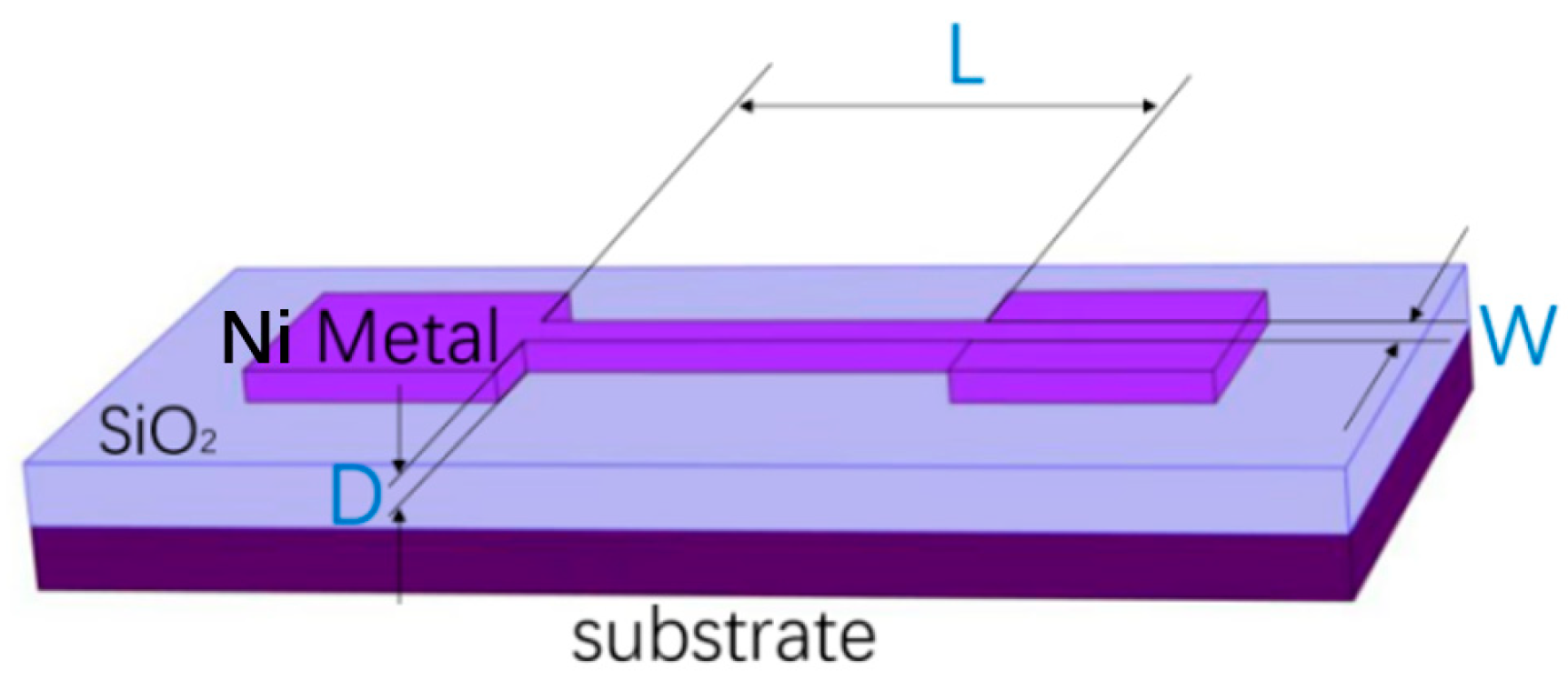
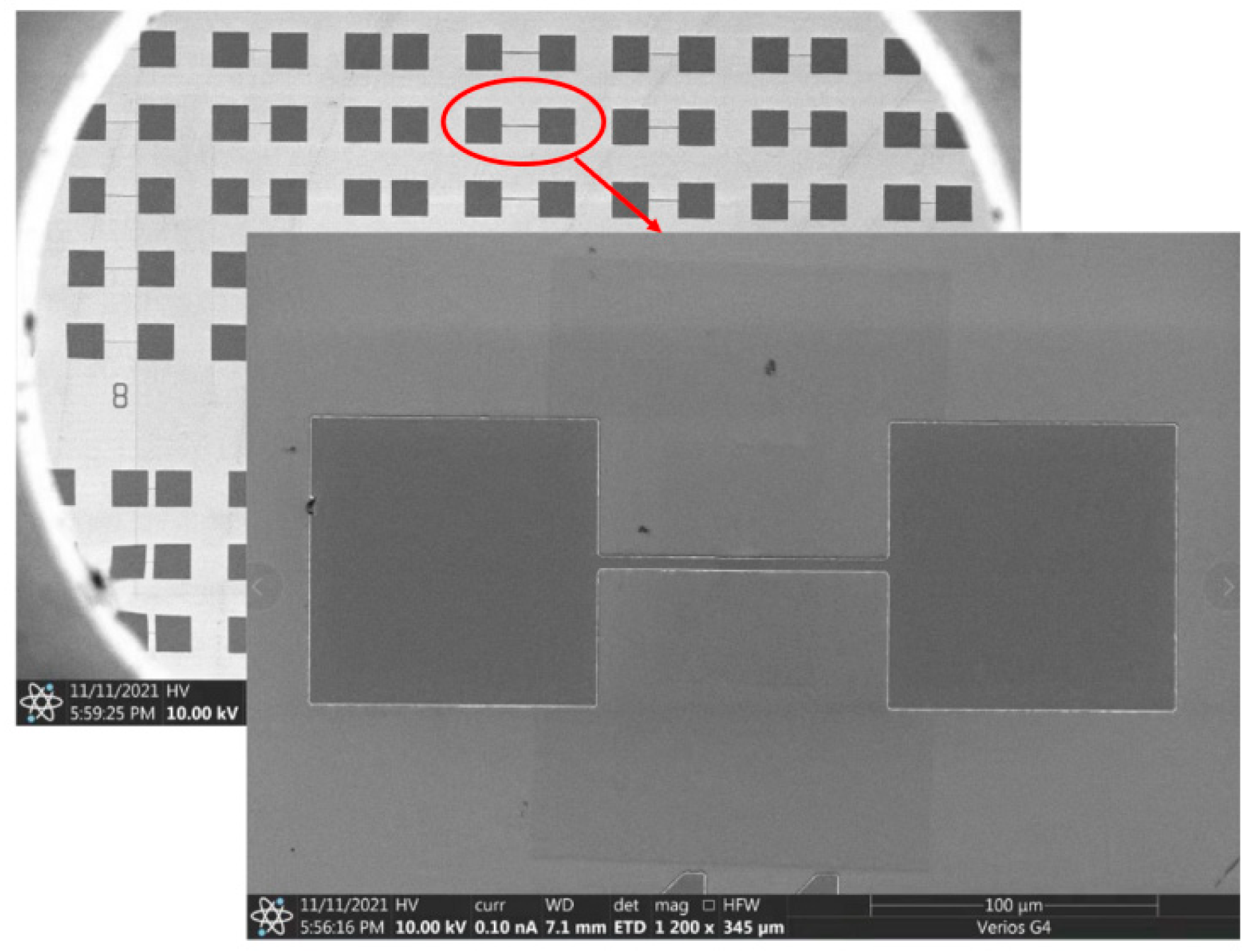
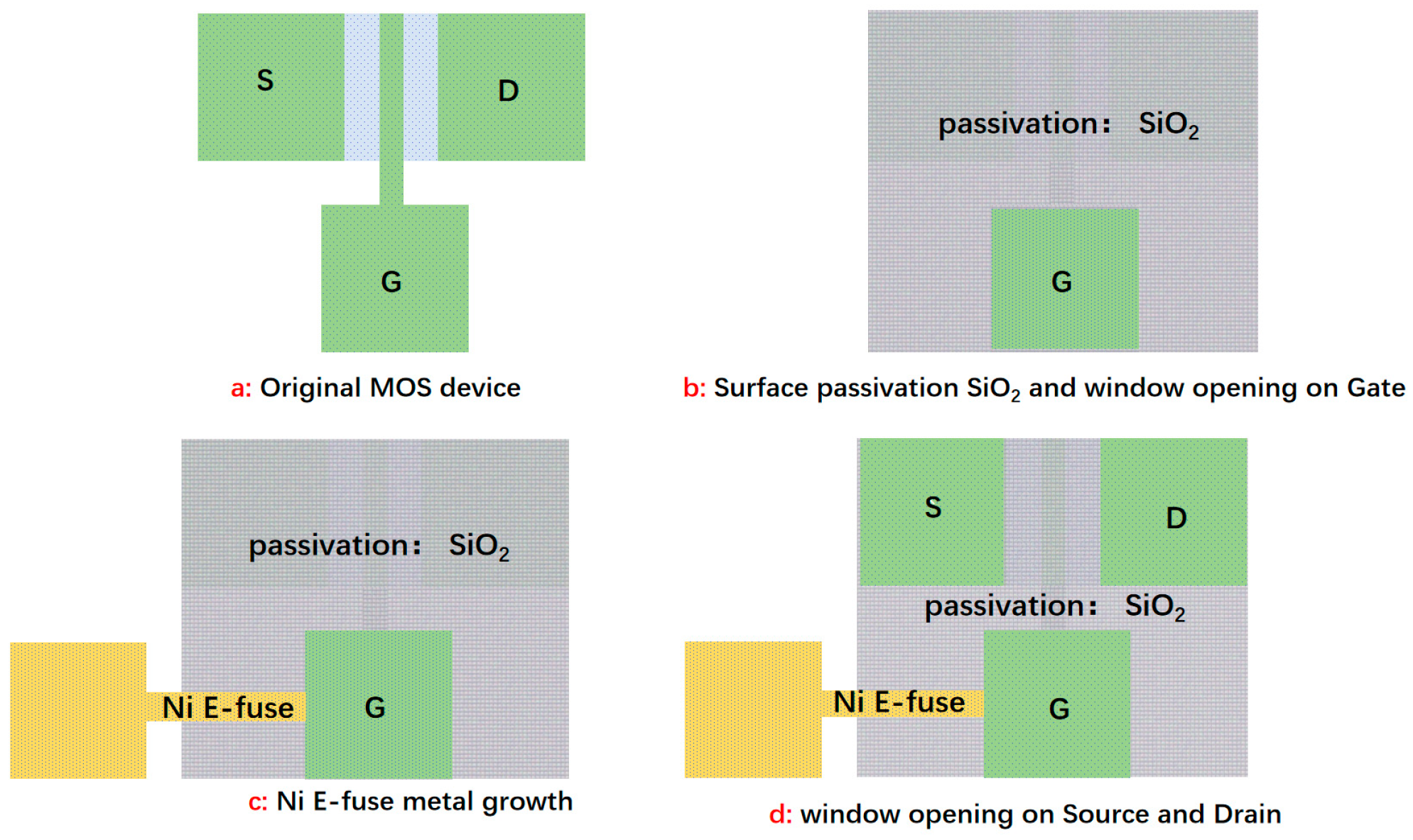
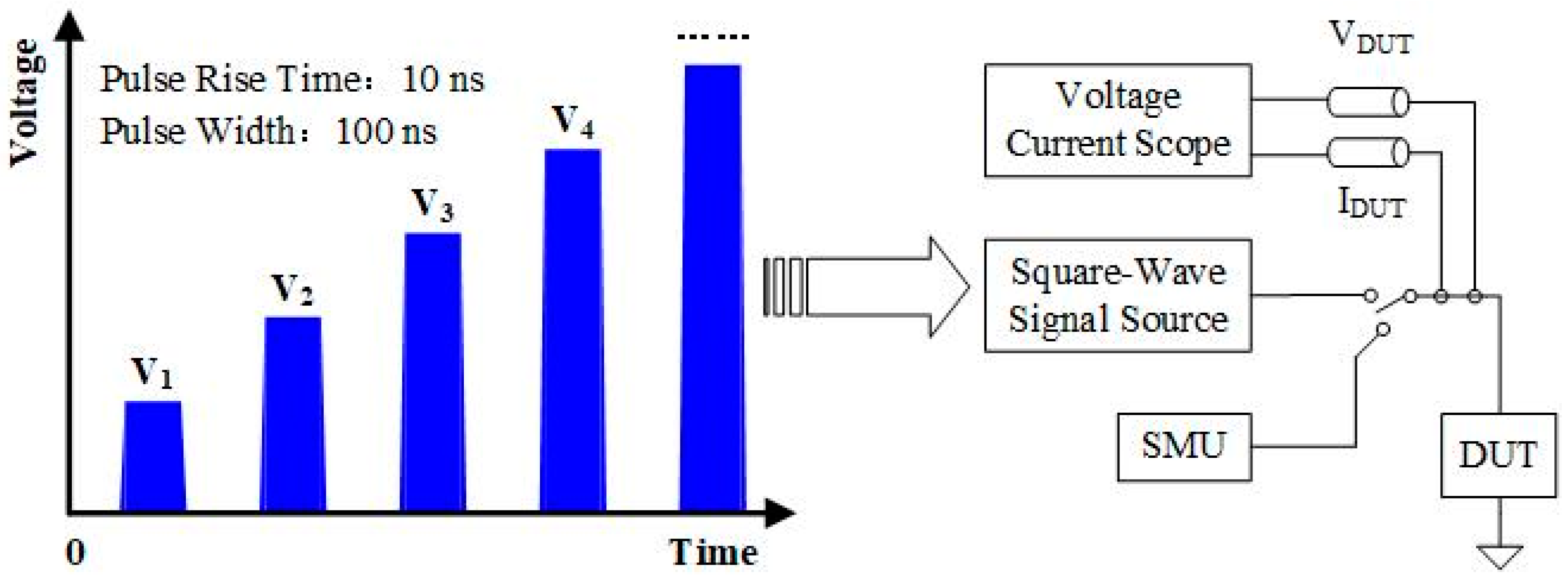
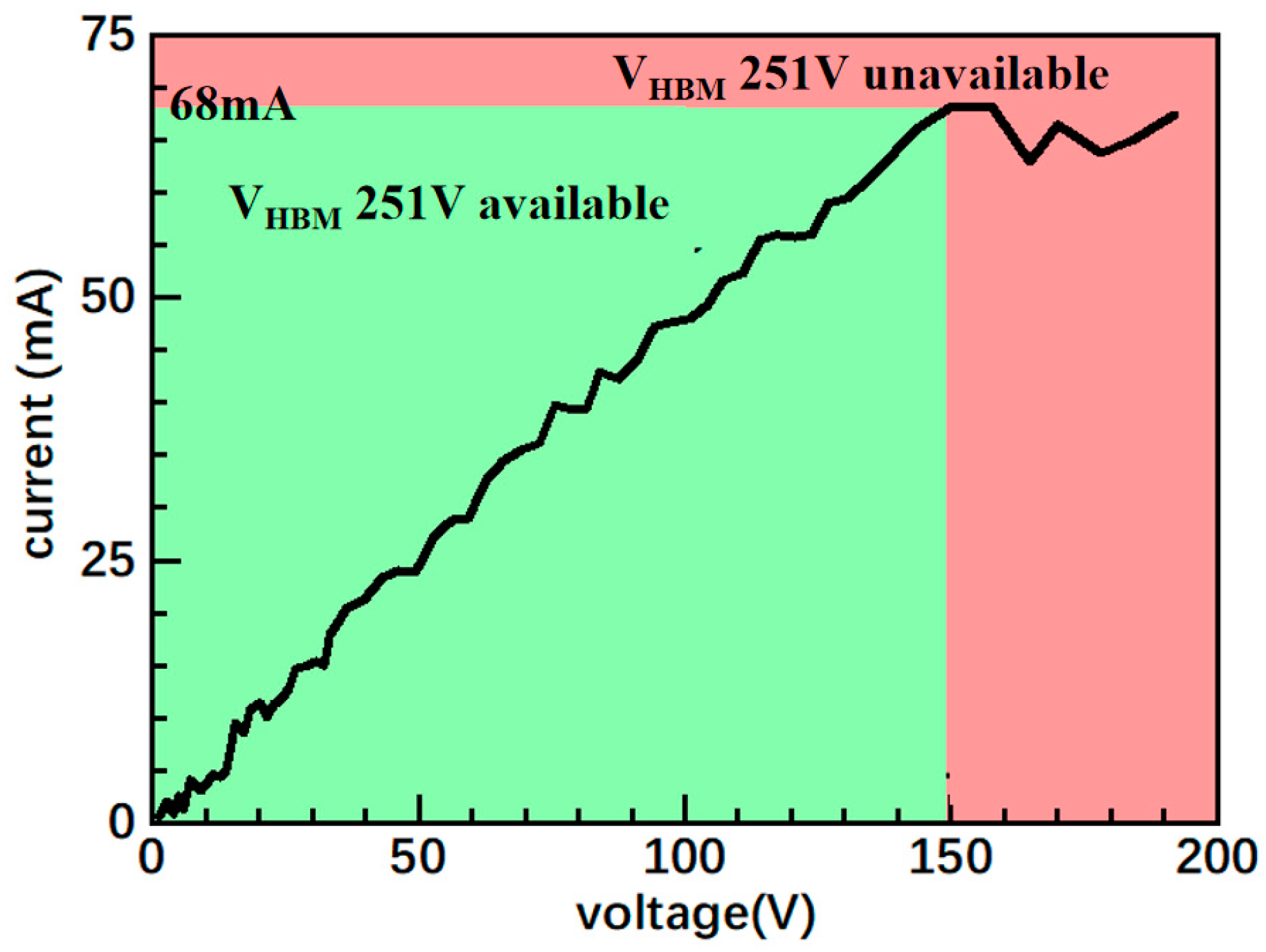
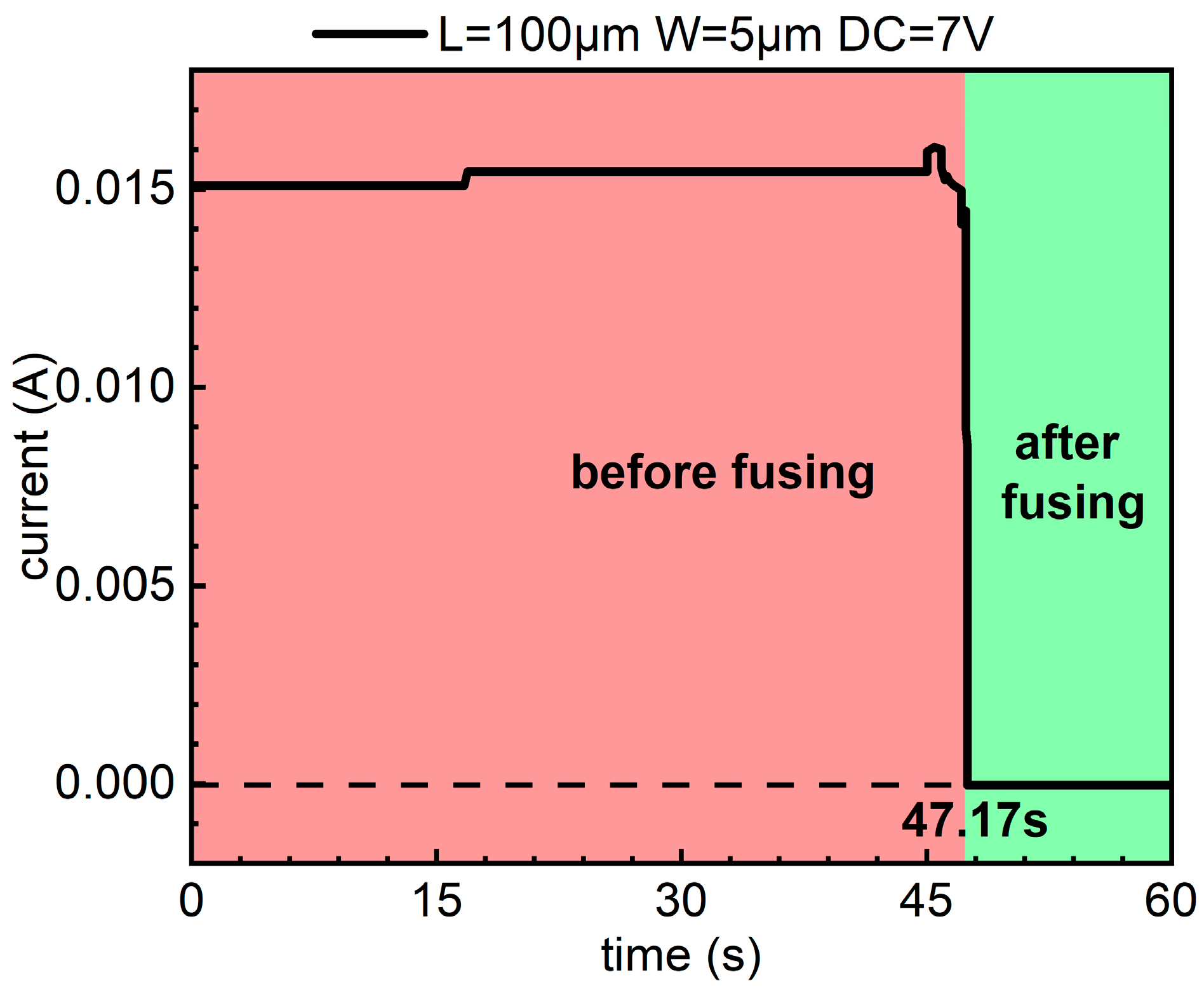
| D/[nm] | L/[μm] | W/[μm] | Fusing Voltage/[V] | Fusing Time/[s] | Fusing Resistance/[Ω] | Fusing J/[mA/μm2] |
|---|---|---|---|---|---|---|
| 50 | 100 | 5 | 7 | 47.17 | 3200 | 61.25 |
| 50 | 30 | 3 | 4.5 | 11.22 | 1600 | 84.38 |
| 50 | 30 | 3 | 5 | 10.76 | 1600 | 104.17 |
| 50 | 25 | 5 | 5 | 3.57 | 800 | 125 |
| 50 | 25 | 5 | 6 | 2.1 | 800 | 180 |
Disclaimer/Publisher’s Note: The statements, opinions and data contained in all publications are solely those of the individual author(s) and contributor(s) and not of MDPI and/or the editor(s). MDPI and/or the editor(s) disclaim responsibility for any injury to people or property resulting from any ideas, methods, instructions or products referred to in the content. |
© 2024 by the authors. Licensee MDPI, Basel, Switzerland. This article is an open access article distributed under the terms and conditions of the Creative Commons Attribution (CC BY) license (https://creativecommons.org/licenses/by/4.0/).
Share and Cite
Guan, H.; Li, J.; Chen, Y.; Tang, Y.; Li, Y. Exploration of a Novel Electric-Fuse Device with a Simple Structure of Ni Metal on a SiO2 Dielectric for Electrostatic Discharge Protection under a Human Body Model. Micromachines 2024, 15, 1163. https://doi.org/10.3390/mi15091163
Guan H, Li J, Chen Y, Tang Y, Li Y. Exploration of a Novel Electric-Fuse Device with a Simple Structure of Ni Metal on a SiO2 Dielectric for Electrostatic Discharge Protection under a Human Body Model. Micromachines. 2024; 15(9):1163. https://doi.org/10.3390/mi15091163
Chicago/Turabian StyleGuan, He, Jiaying Li, Yangchao Chen, Yongchuan Tang, and Yunshuo Li. 2024. "Exploration of a Novel Electric-Fuse Device with a Simple Structure of Ni Metal on a SiO2 Dielectric for Electrostatic Discharge Protection under a Human Body Model" Micromachines 15, no. 9: 1163. https://doi.org/10.3390/mi15091163






